You know those sales pages that are really, really long? They’re great, but they mostly suck. I mean, the way they’re usually implemented sucks.
Long-form sales pages have their place, and they can increase online sales in many circumstances. (Hell, we use them.)
Think about it. The reason you have a website is because you want to sell something. If you have only a single product, there’s no real reason to have more than one page. The only information you need to have on your site is what helps the user understand the product (i.e. its benefits and use cases).
This helps consumers come to a decision as to whether the product solves their particular problem quickly. Clicking through several different pages only gets in the way.
Some call that format a mini site; some say one-pagers. Same same.
If you’re using landing pages to capture PPC traffic, and you want users to buy something, you’re probably (or should be) using a sales page, too.
Table of contents
Do you need long copy on a sales page?
The amount of copy you need depends on the complexity and cost of the product. The more complicated and/or expensive the product, the more you need to explain, show, educate, convince.
If you’re selling a box of matches for $0.25—and I need one—I don’t need to read any copy. I just buy it. The product is simple and cheap.
On the other hand, if I’m in the market for a new car or house—both complicated (many things to learn about them) and expensive—I will take weeks and months to do research, read, and compare.
If you’re selling something that costs, say, $300, I don’t need weeks, but I do need enough information before I can justify (to myself, to my wife, to my boss, etc.) such an expense.
Buyers are readers
Worried that your copy is too long? Don’t. If somebody is ready to buy after just a brief skim (having just read ~20% of the copy), they can just skip ahead and click “Buy.” No problem.
But if somebody reads all the text on your site and still has questions and doubts, then you’ve got a problem. This is why long-form copy works well for sales pages.
True, most people will not read the whole sales copy, and that’s okay. It’s not a novel. The consumers who do are the ones who are actually going to buy. As Ramit Sethi explained in an interview:
“My sales letter for Earn $1k is 47 pages long, but it converts very well. And when people read it, they will do things like this, they will nod their heads as they are reading the entire thing. We’ll see them stopping and we’ll see them resuming again. They’re really thinking about it.”
Are long-form sales page cheesy and scammy?
This is the reason I said that they mostly suck. I agree—most of them are ridiculously cheesy and scammy. You’re absolutely right. This is why a lot of people hate them.
Bad examples of long-form sales pages
I went over to Clickbank and picked some random products from their marketplace. Here are three typical long-form sales pages:
Bad example of a long-form sales page #1
Exclamation marks! Check. Hype! Check. THE Absolute best! Check. This must be selling like crazy. (In case you were wondering, it’s not.)
Bad example of a long-form sales page #2
They couldn’t even get their logo display right, and the headline is unreadable.
Bad example of a long-form sales page #3
Another case of a “proven” headline formula at work.
Some cold, hard truths about long-form sales pages
- Most of them look like vomit. Worse, actually.
- The copy is written by idiots who think that adding exclamation points and hype into every sentence boosts sales. (Grow up.)
- A lot of the products sold via long-form sales pages are actually scams. It looks like the easiest business—just create a PDF and start selling it. That’s why it attracts a lot of losers. The barrier to entry is extremely low, so any idiot can get started.
If you Google long-form sales copy, you’ll find lots of critical blog posts, such as this one, but you’ll also see that the criticism is all about implementation.
I want to remind you: It’s not the format that sucks. It’s the execution.
- Long-form sales pages can look great.
- It’s possible to hire somebody that can write great copy.
- Great products can be sold with long-form sales pages—not just shady infoproducts.
Here’s an example of a long-form sales page we use for CXL Institute. The copy isn’t cheesy. It’s not a high-pressure sales pitch. The page looks good.
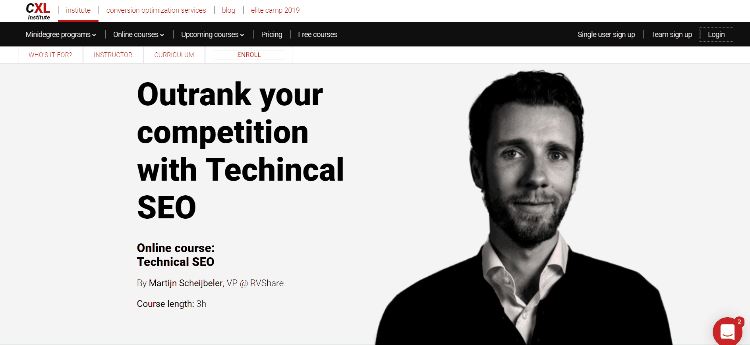
6 tips for designing long-form sales page
Follow these tips if you want to craft a long-form sales page that converts:
Copy matters—it’s first above all else
Long-form sales pages are mostly about the content. To close the sale, you need really good copy. You don’t start to design before you have the copy in place. Content first.
You can write excellent copy only if you understand your target audience and master the “little things”—like knowing your way with words, understanding persuasion, sales psychology, and using proven frameworks.
Jerry Seinfeld should assuage your fears about long copy—if it’s good:
There is no such thing as an attention span. There is only the quality of what you are viewing. This whole idea of an attention span is, I think, a misnomer. People have an infinite attention span if you are entertaining them.
While Jerry was talking about television, his insights apply to sales copy. No one is going to read it—no matter the length—if it’s boring crap. It needs to join the conversation in the mind of the customer, target their problems, and show them how you’ll help them achieve their desired outcomes.
I’ve written a thorough article called “Quick Course on Effective Website Copywriting”, but note that this article is more about the process and less about the style or techniques.
Be careful about picking a copywriter
I’ve used a ton of copywriters for various projects. My best advice: Anyone worth hiring starts at $1,000 (usually much more, in the $2,500–5,000 range). You’re better off learning copywriting and writing your own copy than hiring somebody cheap. People who are cheap are cheap for a reason. (They usually suck.)
Of course, price alone doesn’t tell you the quality of the copywriter. There’s a myriad of jargon-loving “professional copywriters” out there (and I’ve had the misfortune of using several). If they’re using stuff like “leverage” and “our principals are standing by” in their portfolio copy, run!
A lot of them are also ego-driven (which is understandable—they’re human). But that makes them poor at taking feedback, fierce about justifying their choices, and results in mediocre copy (at best). Still, great copywriters do exist.
Decide what kind of copywriter you need
Another thing to remember is that brand copywriters and direct response copywriters are very different. We once hired a brand copywriter who had an impressive resume and had worked with all sorts of big brands in the past. She completely failed at writing direct response copy. She just couldn’t figure it out.
If you’re doing copywriting in-house, I strongly recommend this book. It teaches an awesome technique for improving copy through synergy and a systematic approach—without anyone’s feelings getting hurt.
It’s (almost) all about readability
So you’ve got good copy. Congratulations? Not quite. If it’s not structured and designed well, people aren’t going to read it.
First, there’s how you structure your text:
- Large font size (minimum 16px);
- Short lines (40–80 characters per line);
- New paragraph every 3–4 lines;
- Use lists, quotes, tables—mix it up;
- Sub-headlines every 2–3 paragraphs.
This is basic but oh so critical. No one is going to read a wall of text like this one:
Sub-headlines are completely missing. Most users will read only the headlines—they use it to garner the entire story from start to finish. Scanners will scroll down the page, stop at headings that grab their attention, read that content, and resume scanning.
Use novelty to keep users engaged
To make a lot of copy easy to digest and read, you need to design for reading. Provide novelty on every screen.
You have to change the layout constantly to keep it interesting. Sameness equals boring and drives people away. There are lots of psychological phenomena at play, which I’ve written about here.
- Neuroscientists say novelty promotes information transmission.
- Our minds gravitate toward novelty. Not only does a novel experience seem to capture our attention, it appears to be an essential need of the mind.
Our brain pays close attention to patterns and quickly learns to ignore anything that is routine, repetitive, predictable, or just plain boring. This makes room for paying attention to anything that’s different. Novelty is what gets people to pay attention.
Ever wondered why so many sites constantly alternate the position of text paragraphs—text on the left, then on the right, then back on the left, and so on?

It’s for the very same reason I just mentioned—novelty. It boosts the number of people reading the content. Sub-headlines and white space help to achieve the same goal.
Test a video version
Video can boost conversions, and long-form sales pages are no exception.
While video-only sales pages can be successful at times, in most cases video should be supplemental for the text. Most people will not watch the video. (The most interested people might.) The text content should be created with this in mind.
A while ago, we tested two “text-only” vs “video+text” long-form pages against each other. In the first test, sales pages were identical except for one thing—one had an image above the fold (left), and the other had a video (right):
Result: The video version drove 46% more sales.
The second test was similar. Everything was the same except for the above-the-fold area.
Result: The version with the video got 25% more sales. (And, hard to believe, but auto-play converted 13% better here than “click to play.”)
Don’t make users leave the page
Sometimes, you have additional information that’s useful to some, but not all, readers. On “regular” websites, you could just link to a deeper page, but on mini-sites you can’t (or shouldn’t). So here’s what to do instead.
Expand/collapse information
In this example, a mini-site is used as a one-page FAQ. When you click on a question, it expands to show the answer. This design helps you make the page shorter and also makes it easier to find the question and answer readers might be looking for.
Open info in a lightbox
You can “hide” information behind a click, but instead of navigating away, open it in a lightbox:
Great visual design matters—a lot
Oh, where do I start. Design is half the marketing-and-sales battle. Great design builds trust and guides the reader. It also highlights important information and minimizes secondary content.
If your site looks like crap, the perception of your product will also be crap. Look at the three examples near the top of this article. Would anyone on the planet see those pages and say, “Yeah, these look like trustworthy sites”? Don’t think so.
Good design isn’t about bells and whistles. Great conversion-optimized design serves only one goal—getting people to buy. Any part of the design that doesn’t support this goal has to be changed or removed.
I’ve seen blog posts touting the idea that “ugly websites convert better.” In every case where this was claimed and where the “good design” version was actually shown, the good design sucked.
Here’s a screenshot from a forum thread:

The thread starter never posted the pages for comparison, so a part of me thinks this is all made up, But, let’s look at what’s being said here. “Professional looking,” “a lot of cute images, graphics… the works.” Oh my god. Perhaps we should be thankful that they didn’t post screenshots. I can only imagine.
It looks like the reason that some people think ugly sites convert better is because they think sites full of business porn and image sliders typify “good design.” They just don’t know what good design looks like.
Let’s look at some of the arguments made for “ugly” design and against “good” design.
- “If your website looks BMW-fancy your visitor is going to assume BMW-pricing.” Give me a break. They can see the actual pricing. If BMWs came with Suzuki pricing, everyone would drive one. So if your site looks like BMW—but the product costs like Isuzu—you’ve got a winner. Also, iPads are still the best-selling tablets around. Ever seen their site (and the price tag)?
- “Trust – Nobody likes advertising.” Yes, trust is uber important. But it’s the other way around. Great design builds trust; crappy design kills it. The connection between great design and advertisers is stupid.
- “Accessibility – Build for technology two cycles back.“ The claim that good design is somehow not accessible is silly. Good design is most definitely built with accessibility in mind.
- Google, Amazon, eBay, Craigslist are ugly. First of all, they’ve never been “ugly,” always “good enough” (except for Craigslist). And in case you haven’t noticed, Google has undergone a design revolution and takes design very seriously. Both Amazon and eBay got a face-lift relatively recently. Craigslist is a unique case (there’s always one), and it’s a success since it’s always been like that. Try starting a new, unknown site today that looks like Craiglist and see how far you get.
- “Ugly websites are simple.” This is a non-argument. No reason why beautiful websites can’t be simple. Look at Simple, Blossom, Customer.io. There are a gazillion simple-yet-beautiful websites.
- “The content should always be the highlight of the website – not design.“ Yes, indeed. Design is always there to support content. But design helps users read the content, not the other way around. In fact, in ugly websites, the ugliness gets in the way of the content.
- “I tested ugly vs. a newer more sophisticated version and the ugly one won!” Without seeing the “better designed” version, it’s impossible to comment. My guess is that the better version had automatic sliders, stock photos, and other superfluous stuff. No wonder then. Until I see the ugly vs. good design side by side, these arguments are worthless.
- “See – here’s a case study.” In this case, the answer is given at the end of the article: “It has everything to do with providing the CTA in the correct place in the thought sequence.” The “pretty” version gives you very little text (poor copy, too), then asks for money. No wonder it didn’t work. The “ugly” version actually sells you the idea before asking for anything. Now, if they’d take the copy and structure of the ugly site, but make it look good—I bet we’d see improvement.
- “But this ugly site sells well!” I bet it would sell even better with a good design!
Any cherry-picked ugly site that converts well does not support the claim. The logic of “If X is ugly and sells a ton, then I’ll make an ugly site and sell a ton, too,” is a causal fallacy. What about all the beautiful sites that convert well. Oh my, a contradiction!
We’ve improved conversions on every long-form sales page we’ve worked on. Sometimes, by changing only the design! Give me an ugly page, and we will make it convert better.
People judge everything they see. We meet somebody new—we judge them by their looks. We go to a new place—we make up our mind about it based on its looks. Your friend gets a new car—we decide whether we like it based on the shape of the frame.
When people see your website, they form their opinion in less than 50 ms—and create a long-lasting impression. (If it’s ugly, it will haunt you even if you re-vamp your site. I wrote a whole post on the importance of first impressions that I recommend you read.)
These impressions have a strong influence on conversions.
Three examples of awesome (and high-performing) long-form sales pages
Every single page converts very well. How do I know? We built them.
One of the best-selling fitness products.
LinkedInfluence
Notice that this version is slightly different than the one I showed above in the video test example. This one converts more than double compared to version they had before we came along.
The Timeline Blueprint
This was built in conjunction with a high-converting email capture page.
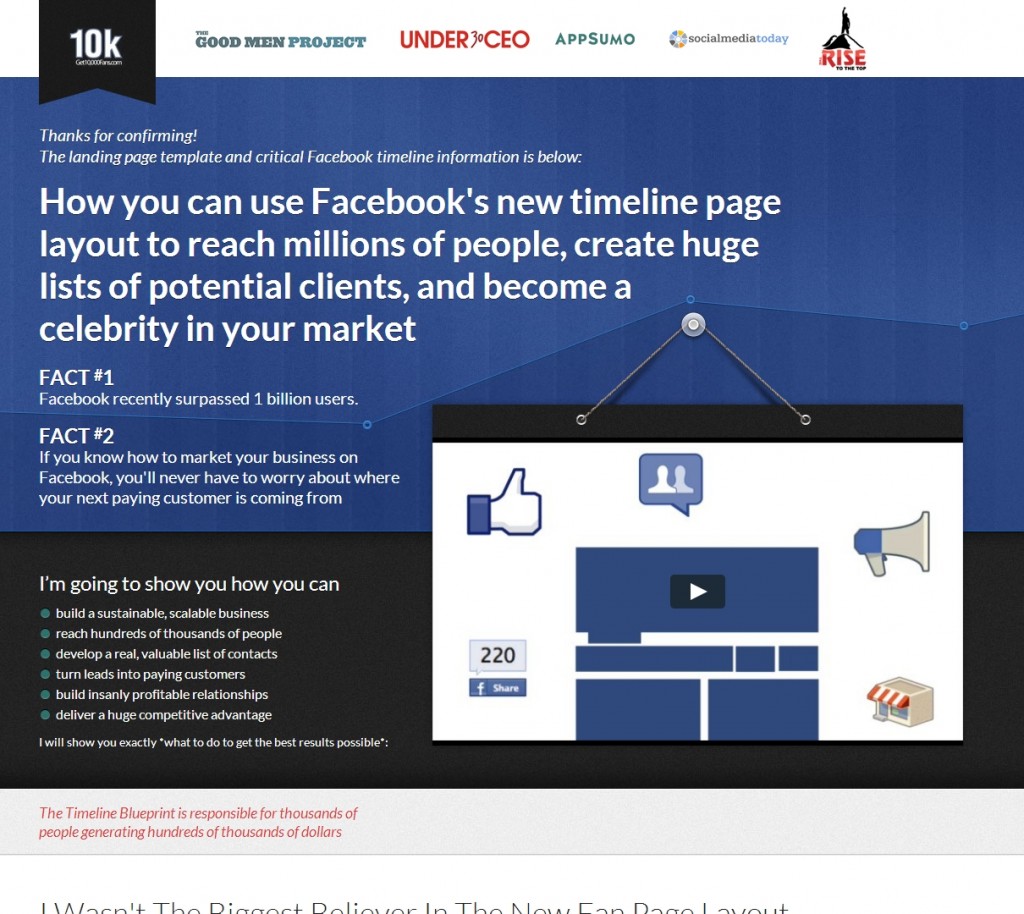
Conclusion
Long-form sales pages have their place. If you have just one product or service—or use a PPC landing page where you want people to buy something right away—it’s a good idea to use one.
Most long form pages suck. But it’s not the format—it’s the execution. Strong research, great copy, and good visual design have to go hand in hand to drive conversions.
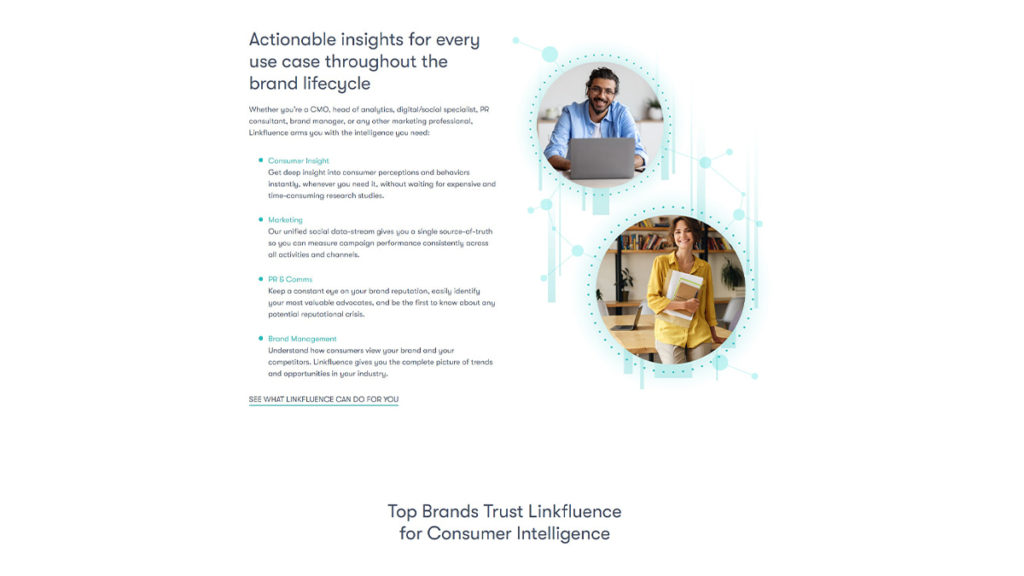
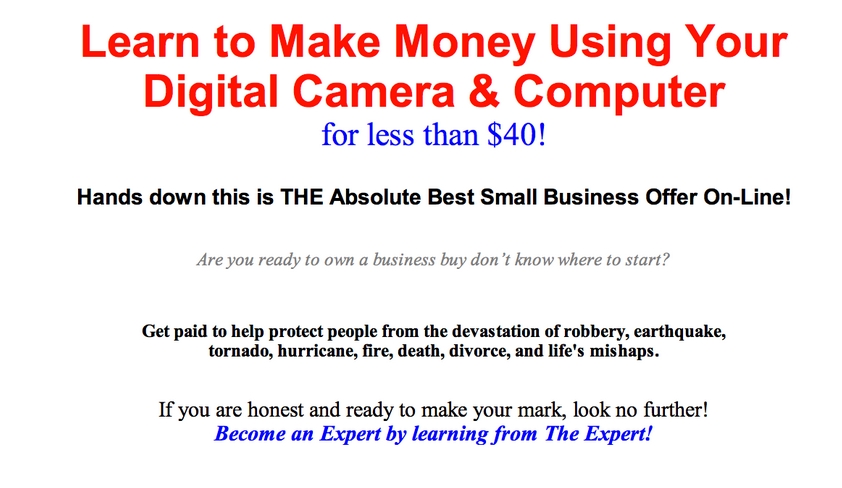

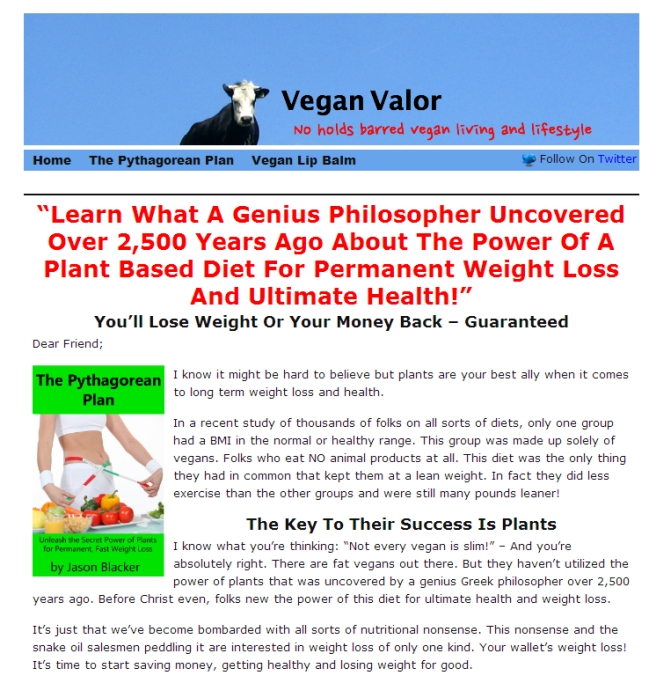
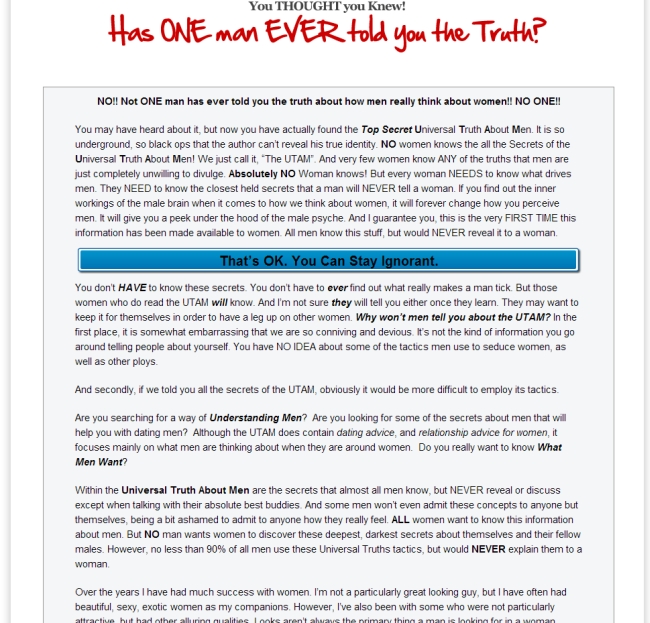
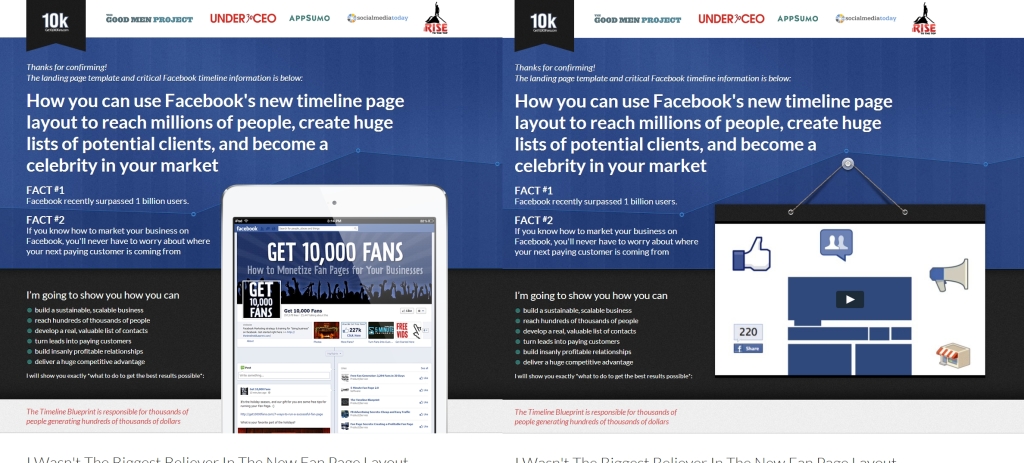



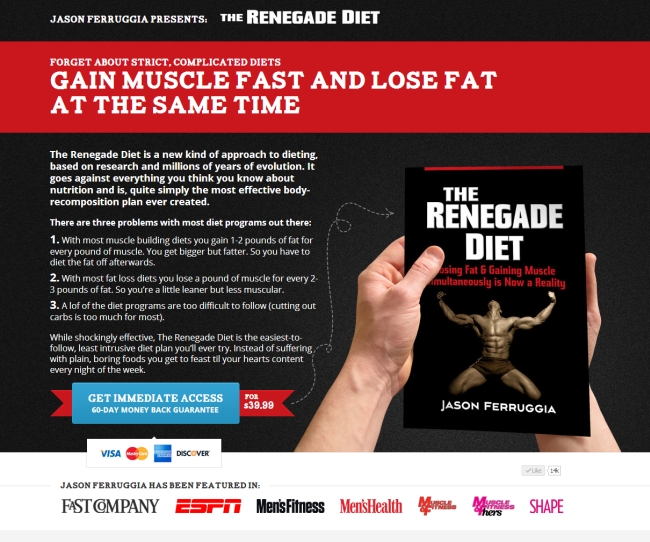

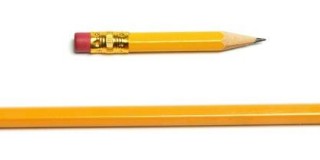

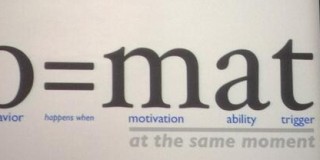
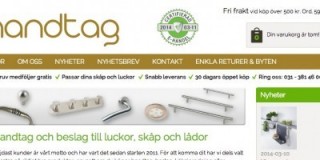
Peep,
Great stuff. Regarding readability, I’d add that line-height is also important. Too many sites get this wrong.
Yup, definitely
Outstanding article as always.
I can feel your tone is more and more “harsh”.
Which as 2 effects in my opinion :
1. It’s much funnier to read.
2. It’s makes the idea of working with you more scary.
Thank you
Haha, I guess I’m feeling more and more comfortable in my blogger skin, so the “real me” is coming out more and more ;) I feel there’s too much PC and tiptoeing going on everywhere, so expressing how I really feel about things is something I want to do more and more. Harsher – yes, but also more honest. And I hope more entertaining.
Peep,
I know exactly what you are saying. I’ve been a blogger for years now, and I’ve always wished I could write like theoatmeal author does. He pulls zero punches, is rude as heck, but probably one of the funniest and most honest guys on the web.
I’ve experimented with the brash style of writing, but it’s not really my personality, so it doesn’t work for me. I didn’t feel your article was harsh at all, and your writing style is easily read.
By all means, be comfortable in your “blogger skin” and write as your real self. Readers love to read honest articles as long as the “real you” isn’t a complete jerk that no one likes in real life. :D
Thanks for the quality article.
PS – you have some sort of addon that just gave me an error when trying to post the above and called me a cheating spammer. I’m guessing it’s because I had put the extension to the oatmeal’s web url at the end of his site name.
Excellent post, Peep! This is my favorite piece on your site, so far.
I really couldn’t agree more and I find the myths about ugly pages doing well so annoying… as you say: too few people even understand the basics of good design to make such a call.
I also love the examples of pages you included.
Thanks!
Awesome Post, very inspiring to see someone sharing such great value content and well structured writing. I think is blog post is a long copy sales page in itself – great depth and insights here Peep, thanks for sharing, looking forward to the next one!
Thank you Josh
WOW!
It is like you spoke directly to me. Maybe you did ;)
This post is so valuable it should have came with a price tag of its own.
NOW I know what you meant when you said:”For this price your site needs to look more expensive and exclusive. You don’t expect this price after arriving on your minimalistic site.”
Before this post I had NO IDEA how to make a long copy sell without going all info-marketing on it.
I have just the praise and highest regard for you Peep.
KEEP WRITING!
Haha, awesome :)
Great post!
It re-enforces my long held belief that content is King and design is Queen.
Indeed
Great stuff. And I liked the work you did on Brian’s email capture page too – studying that is a little hidden bonus. And you seem to have worked wonders with a non-standard looking Optimizepress site there too.
Ian
Thanks. Everything we design is always 100% custom. No Optimizepress templates used.
Hi Peep – that wasn’t my point – I’m sure your page designs are 100% custom – but you’ve done it by creating brand new templates for Optimizepress right? (timeline blueprint and renegade diet are running on Optimizepress according to the page source).
Presumably you did it this way so they could run a membership site or something underneath using Optimizepress.
Ian
Thanks for sharing this article, it’s still crazy to see some of the long form sales pages still in existence over on ClickBank. It’s always so refreshing when you come across one that is actually done well.
Yeah, tons of crap in there
Nice post man.
I see a lot of fitness guys having really nice sales pages. Craig Ballantyne’s HomeWorkoutRevolution (Google it) is way better looking than his TurbulenceTraining site. Jason’s new site looks really good too (I didn’t know you guys created it). Also, the BioTrust guys (protein powder by Joel Marion) is clean, elegant, and simple. So I see it as a growing trend.
But I wanted to get one thing clear: do you have a bias AGAINST info-products, or are you saying that info-products have a low barrier to entry, so any fool can whip up a crappy product and an junky sales page and start selling?
I’ve always been fascinated with info-marketing and when you look at guys like I mentioned above (plus Rusty Moore’s Visual Impact series) it’s pretty amazing how well they do with their copy. Another GREAT fitness site that just recently updated their sales page is MaxWorkouts. They had a good converting site before, but with their new design, I’m sure they’ll do even better.
Thanks,
Raza
No I have nothing against infoproducts per se, it’s just that there’s a ton of crap and scam among infoproducts due to low barrier of entry.
Yes! Finally someone talking sense (with awesome examples) about landing page design.
Thanks Peep, great blog post.
Appreciate it!
Great post. Thanks for the Mixergy shoutout with Ramit Sethi.
Cheers
Yes, excellent post. Try getting clients away from the wall o’text, however. It’s a struggle for sure.
Are they interested in money? Ample proof available that no-wall is the way to go + “lets test it and find out” always helps.
Wow, Huge Post. Very useful.
I’m glad!
Awesome post. Design definitely matters.
I’m running a test soon to see if using a high quality readable sans-serif font like Proxima Nova improves readability (and hopefully conversions), along the same vein.
My suspicion is that readability is even more important on a long-form wordy sales page.
Don’t waste your time on testing fonts. All standard web fonts are easy to read.
Wow. I’m impressed! Thank you a lot!
Peep, awesome article – agree with all your points. One comment on the origins of “ugly” vs. “good” conversation:
It seem to have first appeared when they were many “pretty” websites that used flash, intros, artsy design and yet non-obvious UX.
So the argument “ugly converts better” on the warrior forum that you quoted comes from comparing an ugly all-text site with a large “Add to Car” or “Download” button vs. an all flash “pretty” website with no buttons.
So “ugly converted better” was true at the time because “pretty”wasn’t designed to convert all.
Now, obviously there is no contest – a site that is designed for conversion, A/B tested and optimized for mobile will kick butt of any “ugly” site.
My two cents.
It might very well be!
I still get a lot of “I don’t want a good design, I want one that converts” in my line of work – many don’t think you can have 2 in 1. They’re wrong.
This is one of the best, if not the best, article covering this topic!
You are 100% right IMHO… Sales Letters and Long Copy is one of the most powerful ways to sell online and NO, they don’t need to look like crap.
Finding great designers with both mindset (sales and beauty) is not easy though ;)
Thanks! Indeed, it’s tough. That’s why it’s a good idea to work with agencies that have a network of talent available :)
Great topic, Peep. But there’s a distinction between “copy that goes long” and long-form copy, where the former is largely what you’ve shown here and the latter is a style of writing that focuses the reader by relying, above all, on a narrative structure – complete with a hook, lead and story – borrowed from the greatest direct response pieces of all time: the sales letter.
When you pull out the narrative, you lose much of what makes long-form copywriting so powerful. The world continues to try to reinvent these pages to please a designerly eye… and yet we always go back to the old way ‘cos it performs so damn well.
The less the prospect is aware about his problem/your product, the more copy you need. There are 5 levels of prospect’s awareness:
1- Completely-Unaware (Doesnt even know they got a problem, Longest Copy)
2- Problem-Aware (know’s there is a problem, but doesnt know there is a solution)
3- Solution-Aware (knows that there is a solution for his problem, but doesnt know about your product yet)
4- Product-Aware ( already familiar with your product, but not sure if its the right one for him/her)
5- The Most Aware (just needs to know the price, he is sold on the benefits)
The earlier they are on the awareness scale,the more copy we need to persuade them to take a action
Peep you did a great job ! Keep them coming.
Make your days great
yassin
The bit I found most thought provoking was the video tests. Have youi tried putting a video below the fold so that interested visitors scrolling down find something new?
The other thing word mentioning (I don’t recall seeing it in the post) is adding calls to action throughout the copy. At the point when the visitors says ‘yup, this is the deal for me’ they have a button to press, a number to call or an email address. However this doesn’t mean putting a belcher button after every paragraph!
I have been enjoying your posts and love your straightforward style. I’ve had lots of split test ideas from reading your previous work. Cheers!
Amazing article!
Appsumos sales page got me interested in redesigning mine and boom! You mentioned it.
Will be saving this man!
P.s I’ve been saying for a while RD sales page blew me away.
You guys created it damn!!
;)
Thought provoking article. This line was a lightbulb moment for me:
“You don’t start to design before you have the copy in place. Content first.”
I’ve always done the design first (either myself or outsourced for larger sites) and then written the copy (long or short form). Maybe because I find the design more “fun” to do than the content and human psychology means we tend to do the “easier” tasks first.
What you’ve written actually makes a heck of a lot more sense – the content being more important than the design.
Thanks for the insight.
Outstanding Article!! I have had personal experience working with a company that would not give up it’s “ugly”. In fact, it was done on purpose for the ridiculous reasons you mentioned above. People simply won’t tolerate it anymore. The web has evolved and so have consumers… the gig is up. BUT, given your excellent argument on content and emphasis on design, you have made me a newfound believer in the long-hated long-form. THANK YOU!!
Peep – epic post. How much time did you spend writing this? 10hrs?
Your style is very unique compared to other folks I have read stuff
from. Thanks for posting when you have the opportunity, Guess I’ll just book mark this web site.
Great Post! I think I’ll be reiterating this all to my employer as our long sales pages suck terribly and it will give me sound ammunition to redesign them for the company. Thanks Peep.
Hi Peep,
Thanks for this, we are just designing a “long sales page” and this will surely help!
I really love this article. I’m a web designer, who doesn’t have a marketing background. But more and more I’m being asked to design sales pages once they have seen a few that I’ve done. Design makes a huge difference, and just lifts up great copy to another level.
I would love feedback on something though. Do you have an idea of what kind of pricing designers are charging for these pages? They take a loooong time. Alot of custom graphics, organizing of text after reading it carefully to pull out the important bits and make it graphical and stand out. And not to mention setting up optins and the download delivery or payment gateway, if that is part of the sales lettter. I’m sure it would depend upon the $ bracket of the designer and of the client. E.g. I’m a solo designer, but clearly not the same kind of clients as design firms. I think I’ve been undercharging a bit, but would love pricing feedback as I want to revise this and give clients a realisitic idea of how long they actually take.
Peep, I know you must be getting a ton of organic traffic from Google… Let me take this moment to say that the content on this page was incredibly helpful, detailed, rich, and comprehensive.
I have saved this into my Evernote and will likely reference it everytime I write some new pages.
Thank you!
Excellent. This was a very descriptive and informative post about the design of the sales page. Thanks a lot.
Great article – there are not many services out there that can do long form copy graphic well. I may have to get a quote from you when i get my copy completed.
I’d have to say, hands down my favorite of the long form landing pages is Appsumo.
It’s bright, clean, simple-ish, and most importantly tells a realistic story. I come across too many long form pages with the ugly “spammy” looking buy now buttons, “hand drawn” arrows of the early 2000 design scheme, and spam like copywrite.
I stumble upon those sites and always wonder how well they convert.
This article is great – WOW.
I like your take on long form one page sales pages.
They suck when they are boring and repeating. I tend to skip half the content, and that is only true if the content grabs my attention.
I get a lot of marketing emails promoting products and sometimes these long sales pages can be so repetitive I don’t bother. After a while you can pick up the same regurgitated marketing sales junk content all over the page.
They start by telling a story, then they make you feel sorry for them and then they attack your senses with all sorts of tactics like scarcity, loss, or if you don’t get it you’ll be left behind and so forth.
Honesty is the only form of true and fair system of trade. In the short term the crap artists will dominate but they don’t last long and they tend to disappear from the scene.
Thanks for the share and finally I really appreciate the effort that has gone into making this article.
This was a terrific and detailed post about on page optimization. Has given me greater insight to assist me in the MMO niche :)